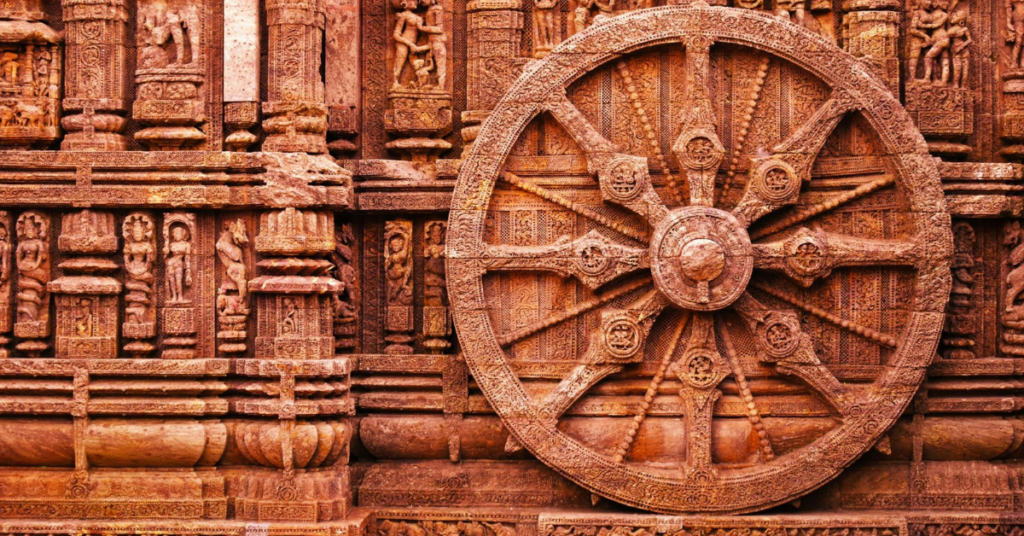
Introduction: The Mystical Aura of Ancient Temples
Have you ever wondered why stepping into an ancient temple instantly calms your mind? It’s not just about faith or rituals. There’s a fascinating science behind temple energy that connects architecture, materials, and spiritual vibrations to human well-being. Temples were not built randomly; they were designed to align with cosmic forces and channel positive energy.
For centuries, temples have been more than places of worship. In ancient India, they served as centers of learning, meditation, and healing. The intricate designs of these sacred structures were based on principles of Vastu Shastra and sacred geometry, ensuring that the temple radiates positive energy. The sanctum sanctorum, where the deity resides, is often built using granite, a stone known for its ability to store and emit energy.
Even the sound of temple bells has a scientific basis. When the bell rings, it produces a frequency that clears negative energy and synchronizes brain waves, inducing a meditative state. Similarly, the practice of pradakshina (circumambulation around the sanctum) enhances positive bioenergy, bringing harmony to the body and mind.
Legend has it that King Rajaraja Chola consulted Vedic scholars before constructing the Brihadeeswarar Temple in Thanjavur. The temple was built with precision to harness cosmic energy, ensuring that anyone entering its premises feels a surge of peace and positivity. Modern research has shown that the magnetic and electromagnetic fields present in ancient temples can positively influence brain activity and reduce stress.
In the sections that follow, we’ll explore the science behind temple energy—how materials, mantras, and sacred designs contribute to this powerful source of positivity and healing. Get ready to uncover the secrets that ancient sages knew long before modern science caught up!
Architectural Healing: The Design Psychology of Temples

Ancient temples weren’t just built for worship—they were designed to heal the mind and body. The science behind temple energy lies in the geometric precision used in their architecture. Temples follow principles of sacred geometry, where symmetrical patterns and aligned structures create a sense of order, stability, and peace
Sacred geometry isn’t just a concept—it’s a science rooted in symmetry and energy flow. The Sri Yantra, often engraved in temple walls, represents cosmic order and balance. Meditating in a space with such geometry helps align your thoughts, reduce stress, and enhance focus.
The design of Konark Sun Temple is a prime example. Built in the form of a massive chariot, its geometric alignment channels solar energy, promoting vitality and mental clarity. Similarly, the Kailasa Temple in Ellora, carved out of a single rock, follows precise proportions that induce a meditative state in visitors.
The acoustic properties of temples also play a key role in energy healing. Temple architecture amplifies the sound of chants, mantras, and bells, allowing sound frequencies to resonate within the structure. These vibrations purify the environment and calm the nervous system. Research shows that certain sound frequencies, like those produced by temple bells, can synchronize brain waves, reducing anxiety and enhancing focus.
Legend has it that sages designed temples to create an environment where the mind effortlessly enters a meditative state. The science behind temple energy proves that these designs weren’t just artistic marvels—they were crafted to promote psychological and spiritual well-being. Step into a temple, and you’re not just entering a sacred space—you’re entering the zone of healing and harmony.To learn more about the benefits of visiting temples, read our detailed blog post and discover how temple visits can transform your life.
Neurological Responses to Sacred Spaces

Have you ever felt an unexplainable calm after visiting a temple? That’s not just faith at work—it’s your brain responding to the science behind temple energy. Studies using functional MRI scans reveal that being in sacred spaces, like temples, activates the prefrontal cortex, the area responsible for focus and emotional regulation. This explains why you feel a sense of calm and mental clarity after spending time in a temple.
Temples also trigger positive hormonal changes in the body. Research shows that exposure to peaceful, spiritually charged environments boosts the release of dopamine and serotonin, the “feel-good” hormones. These chemicals reduce anxiety and promote happiness. When you sit in a temple, surrounded by chanting and divine vibrations, your body naturally shifts into a relaxed state.
The stress-reducing effects of temples are scientifically backed. A study by the National Institute of Mental Health and Neurosciences (NIMHANS) in India found that spending 15 minutes in a temple-like environment can lower cortisol levels by up to 30%. Lower cortisol means reduced stress, better immunity, and a calmer mind.
Temple spaces and meditation also have a deep connection with neuroplasticity—the brain’s ability to rewire and heal itself. Regular meditation in temple environments strengthens neural pathways associated with focus and emotional balance. In fact, ancient rishis meditated in temple premises not just for spiritual growth but also to enhance cognitive clarity and resilience.
Legend has it that Adi Shankaracharya, while meditating at Kedarnath, experienced heightened states of consciousness due to the temple’s serene atmosphere. Modern science now supports this, showing that meditating in sacred spaces enhances alpha and theta brain wave activity, leading to deeper relaxation and mental clarity.
Material Science and Energy Dynamics
Did you know that the building materials used in ancient temples were chosen for their energy-enhancing properties? The science behind temple energy lies in the unique materials like granite, sandstone, and quartz used in their construction. These stones are known to retain and amplify energy, creating an environment that promotes positivity and healing. Granite, in particular, contains high concentrations of quartz, which generates a piezoelectric effect—releasing subtle electric charges that interact with human energy fields.
Ancient architects understood the electromagnetic properties of temple construction. Temples were often built with stones that naturally generate and sustain low-frequency electromagnetic fields. These fields align with the earth’s magnetic field, creating a harmonious space that calms the mind and rejuvenates the body.
Temple site selection was no random decision. Hindu sages and architects chose locations based on geological considerations to enhance energy flow. Temples were often built near underground water streams, fault lines, or magnetic hotspots. These locations amplified the energy of the space, ensuring that visitors experienced a sense of peace and mental clarity. The famous Tirupati Balaji Temple, for instance, is built on a site rich in magnetic and geothermal activity, which contributes to its divine aura.
The interaction of natural materials with human energy fields also plays a crucial role. When you step barefoot on temple floors made of granite or marble, the earth’s energy flows directly into your body, grounding you and stabilizing your energy. This practice, known as earthing or grounding, enhances emotional balance and improves overall well-being.
Legend says that Lord Vishwakarma, the divine architect, crafted temples with these principles in mind to ensure that devotees experienced not just spiritual connection but also physical and mental rejuvenation. Modern research now validates the science behind temple energy, proving that ancient wisdom was well ahead of its time.
Cultural Perspectives on Temple Energy

Ancient cultures worldwide believed that sacred spaces could harness positive energy and promote healing. The science behind temple energy was embedded in traditional wisdom, where spaces were designed to align with cosmic forces. In Hinduism, temples were built following Vastu Shastra, ensuring that energy flows harmoniously through the structure.
Indigenous knowledge also highlights the connection between space and energy. Native American tribes built ceremonial sites aligned with celestial movements to harness earth’s energy. These cultural parallels suggest that ancient wisdom about sacred spaces wasn’t confined to one region—it was a universal understanding of how sacred architecture influences well-being.
Modern Research and Empirical Evidence
Modern science is finally catching up with the science behind temple energy. Recent studies show that spending time in temple environments can positively affect mental and physical health. Research conducted by All India Institute of Medical Sciences (AIIMS) found that individuals who regularly visit temples experience lower heart rates and reduced stress levels.
Measurable health benefits include improved immunity, reduced anxiety, and better emotional balance. Exposure to the sounds of bells and chants increases alpha brain waves, which induce a meditative state. Studies by NIMHANS have shown that chanting mantras boosts cognitive function and improves concentration.
Psychological research also supports these findings. A study published in the Journal of Religion and Health revealed that visiting sacred spaces enhances emotional resilience and reduces symptoms of depression. The calm, structured environment of temples provides a natural antidote to modern-day stress.
Interdisciplinary approaches combining architecture, neuroscience, and spiritual practices are now uncovering how temple energy promotes holistic well-being. As science delves deeper, it becomes clear that the science behind temple energy is a blend of ancient wisdom and modern evidence.
Conclusion: Bridging Ancient Wisdom and Modern Understanding
The science behind temple energy beautifully blends ancient wisdom with modern research. Studies have confirmed that temple environments reduce stress, boost brain function, and promote emotional balance. Temples, built using sacred geometry and energy-enhancing materials, create spaces that nurture both body and mind.
The dialogue between spirituality and science is growing stronger. Modern research highlights how temple architecture, sound vibrations, and sacred rituals influence brain activity and well-being. Ancient sages may not have had scientific tools, but their deep understanding of cosmic energy was remarkably accurate.
If this fascinating blend of tradition and science intrigues you, there’s much more to explore. Platforms like DivyaKripa offer insights into ancient practices and their relevance in modern times. Whether you’re curious about Vastu Shastra, temple geometry, or meditation techniques, DivyaKripa helps deepen your understanding.
Step into this timeless journey and experience how the science behind temple energy can positively transform your life.


